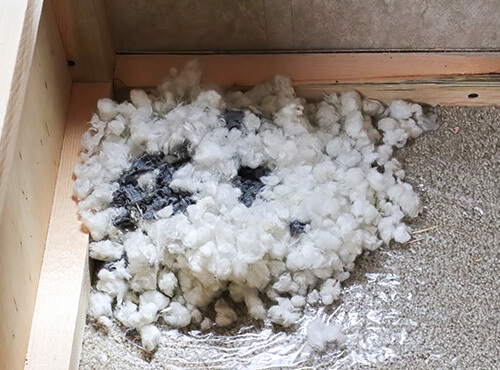Roof rats build nests close to food sources and water sources. Roof rats are omnivores but a roof rat diet consists mostly of fruit, nuts, and seeds over other foods if given a choice. Common water sources that attract roof rats include birdbaths, leaky faucets, and pet bowls.
If your property provides both, you could be at risk for a roof rat infestation.
Where do roof rats nest?
Rats construct their nests in sheltered places away from predators. Roof rats are excellent climbers and build nests high above the ground, unlike Norway rat who dig burrows.
Roof rats prefer to nest in dense vegetation like shrubbery, ivy-covered walls, and overgrown vegetation provide suitable hiding places. They can especially be a problem for citrus farmers in Florida as fruit trees are a popular roof rat nest location.
In the yard, residents may spot roof rat nests in trees, woodpiles, shrubs, and vines. Outdoor infestations often spread inside as the rats take advantage of warmth and food.
In homes, roof rats live in elevated areas like attics, overhead storage spaces, soffits, and the roof. Since roof rats can have multiple nests, removing one is no guarantee that the problem is resolved. Hidden rats living in wall voids and hollow ceilings can continue an infestation even after all the visible nests are gone.
How do roof rats make nests?
Roof rats shred paper, fabric, and insulation to build their nests. They also gather twigs, grass, and other plants in yards. While these materials make up most of a roof rat nest, the rodents will use almost anything soft that they can carry.
Signs of a Roof Rat Infestation
When rats enter homes, they prefer to stay out of sight in undisturbed areas. Roof rats climb walls, run across power lines and tree branches, and squeeze in through small openings in the exterior of buildings to gain entry.
Most Common Signs of a Roof Rat Infestation
- Droppings
- Gnaw Marks
- Rub Marks or Smudges
- Nesting Materials
- Strange Sounds

How to Get Rid of Roof Rats
Easily accessible sources of food will bring fruit rats to your yard. Rats are omnivores and can eat almost anything. Rats can find food at bird feeders, pet food left outside, and garbage cans.
The typical roof rat entry points are through garages, vents, gaps around eaves or rooflines, and windows near trees. Effective rat control requires more than a few rat traps. You need to eliminate why the rats came to your property, remove access to your house, and finally exterminate the existing rat population.
To exterminate already established populations, homeowners may utilize traps, bait stations, electronic devices, and cats or dogs to stave off advancements of rodent populations. However, the use of such tactics may not entirely eliminate infestations. Concerned residents should contact the professional pest removal experts at Critter Control to take care of any rat issues before they get out of hand.
